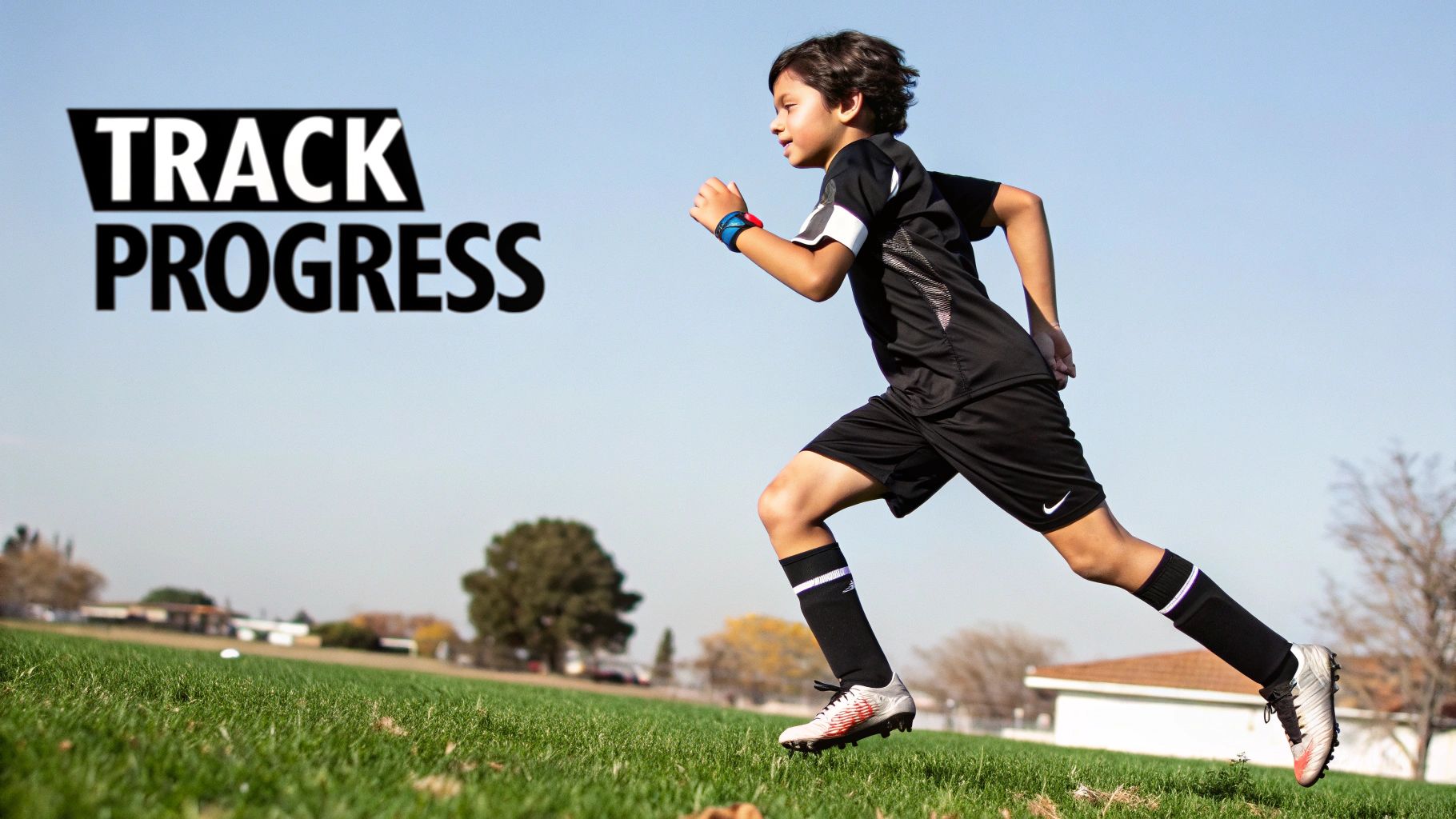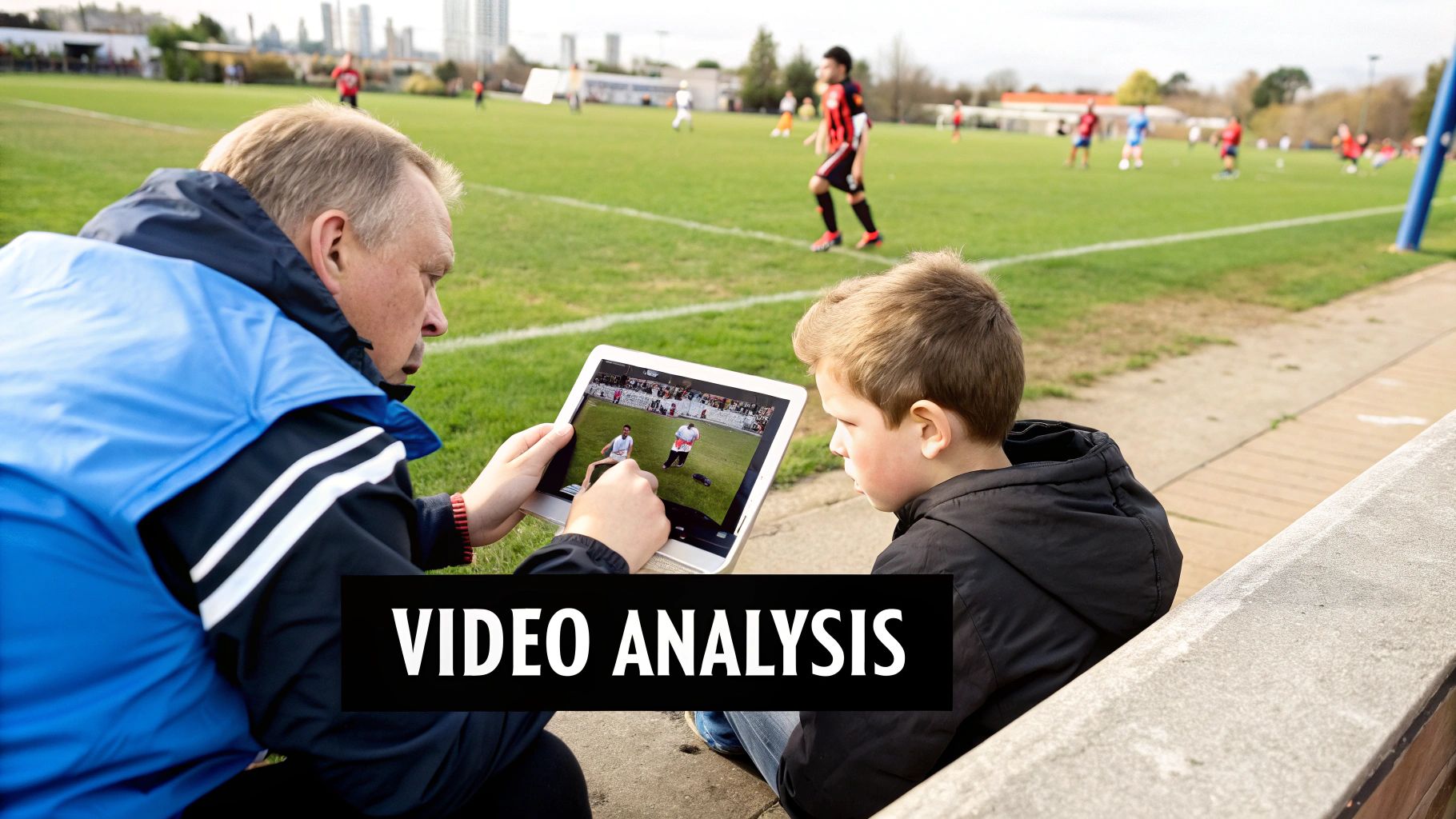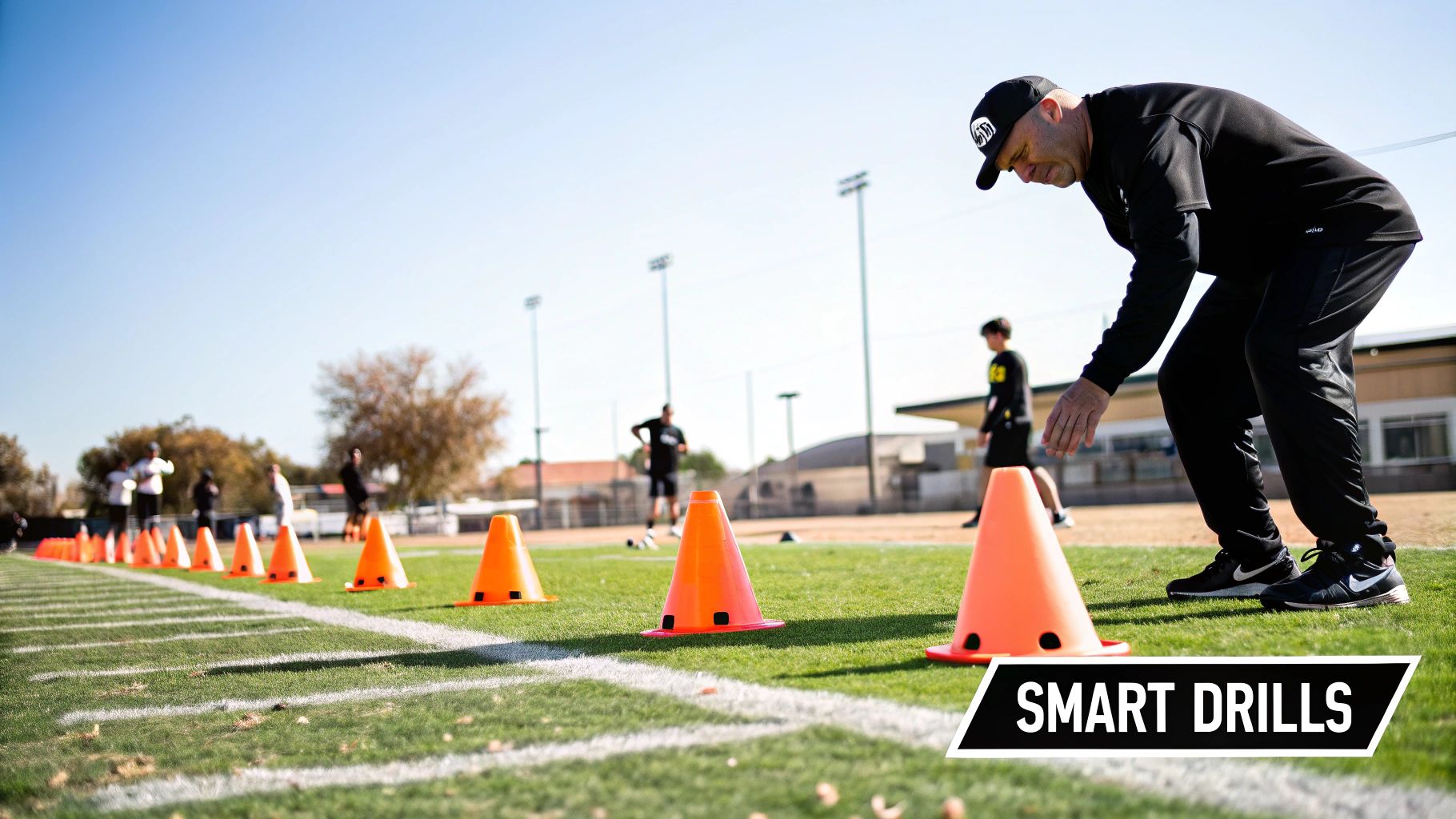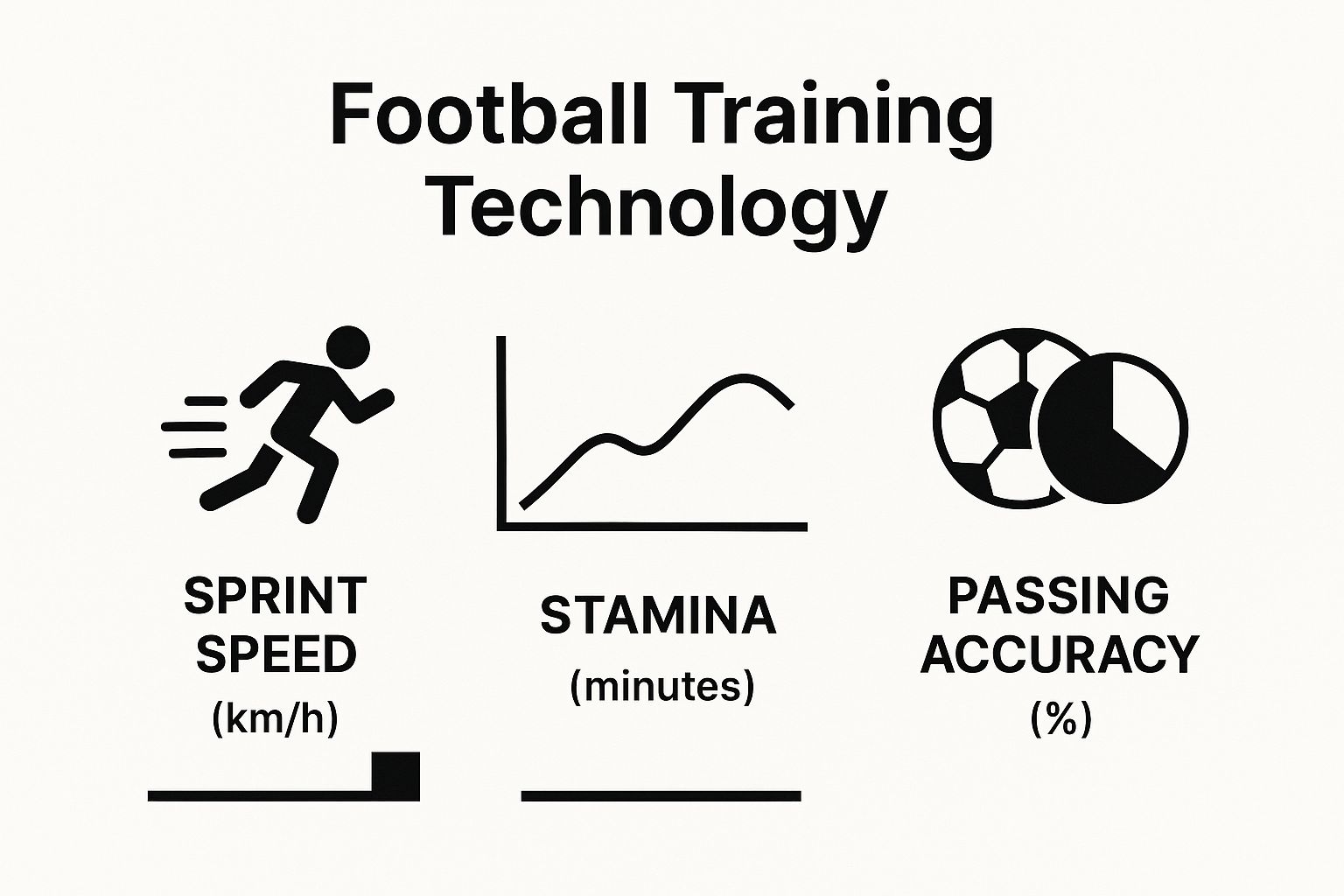Gone are the days when performance tracking was something you only saw on Match of the Day. Today, incredible bits of kit—from GPS trackers that measure every sprint to smart footballs that analyse every kick—are available to everyone. These tools provide the kind of data-driven insights once reserved for professional clubs, helping you support your child's football journey in a smarter, more effective way.
Understanding Modern Player Development
Welcome to the new era of youth football, where technology is no longer just for the pros. This guide looks beyond the usual cones and bibs to explore how modern tools can help your child improve safely and have more fun. We'll walk you through the world of GPS trackers, smart footballs, and performance apps, showing you how to get genuine, useful feedback on your young player's progress.
Our goal is simple: to help you understand this tech, feel confident using it, and play a more informed role in your child’s development. Forget complicated jargon; think of these gadgets as a way to get a clearer picture of your child’s effort, technique, and improvement on the pitch.
Why Does This Tech Matter in Youth Football?
This isn't just a passing trend. The UK sports technology market has been growing at a rate of 12.7% each year between 2020 and 2025, and it’s set to be worth over £1 billion. A huge slice of that growth is coming from tools designed for youth sports, where parents are more involved than ever. In fact, around 60% of parents with kids in UK youth football are already using some form of training tech. You can discover more about how technology is transforming UK sports training in recent reports.
So, why the boom? It comes down to a few key benefits:
- Honest Feedback: Instead of just saying, "You worked hard," you can see that they covered 5km or made 20 sprints. The numbers provide tangible evidence of their effort.
- Injury Prevention: Is your child training too much? Monitoring their workload helps to spot the signs of overtraining before burnout or injuries can occur.
- Keeps Things Fun: Let's be honest, solo practice can become repetitive. Tangible data, leaderboards, and skill challenges make it feel more like a video game, keeping them motivated.
By turning vague ideas like "effort" and "improvement" into real, measurable numbers, this technology gives parents, players, and coaches a common language. It helps you celebrate the small wins and build a genuine, lasting love for the game.
Throughout this guide, we’ll cover everything from how to track on-pitch performance to choosing the right gear, helping you turn all that data into meaningful development for your young footballer.
How Wearable Performance Trackers Work

Let's demystify the most popular bit of football tech out there for parents: wearable GPS trackers. You’ve probably seen professional players wearing what looks like a sports bra under their kit. That’s a performance vest, and it holds a small but powerful GPS pod right between their shoulder blades.
This lightweight setup is no longer just for the elite. Brands like STATSports and Catapult now offer affordable, consumer-grade versions, making this technology widely available for youth players. It captures crucial data that tells the real story of your child's effort on the pitch.
These trackers are much more than glorified step counters. They combine GPS with tiny sensors called accelerometers to measure every movement, burst of speed, and change of direction with incredible accuracy. After a match or training session, all that data is sent to a smartphone app, turning a stream of raw numbers into simple, understandable insights.
Understanding the Key Metrics
At first glance, the data might feel a bit overwhelming, but it really boils down to a few core metrics that are incredibly useful for parents and coaches. Focusing on these helps you get a clear picture of your child's physical performance without getting lost in the detail.
Here are the most important ones to keep an eye on:
- Total Distance Covered: This shows you exactly how much ground your child covered. It's a fantastic indicator of their work rate and stamina.
- Sprint Speed: This records their top speed in kilometres per hour (km/h). Tracking this over a season is a brilliant way to see their explosive power improve.
- Number of Sprints: This counts how many times a player hits their top-end speed. For wingers and strikers, it’s a vital stat that highlights their attacking intent.
The Importance of Player Load
One of the most valuable metrics these trackers provide is Player Load. Think of it as a fuel gauge for your child’s body. It’s a single number that represents the total physical stress they experienced during a session, cleverly combining all their movements—accelerations, decelerations, sprints, and turns—into one easy-to-understand score.
A high Player Load score indicates a tough session, while a low score suggests a lighter one. Monitoring this helps you and the coach see when your child is pushing hard and, crucially, when they might need to ease off and recover.
This is where this kind of tech truly shines for parents. It shifts the focus from just improving performance to actively looking after your player's well-being. By understanding their workload, you can make smarter decisions about rest, recovery, and nutrition—all fundamental for healthy, long-term development.
To get an even deeper understanding, check out our guide on wearable football sensors in our 2025 guide, which explores the technology in much more detail.
Since 2018, the use of these devices in the UK has shot up by around 45% among grassroots clubs. Studies show that by using metrics like these to manage training intensity, clubs can help reduce the risk of overtraining injuries by up to 30%, keeping young athletes on the pitch and out of the physio's room.
Improving Technique with Smart Footballs and Apps

While GPS trackers are brilliant for measuring physical effort, a different type of tech is designed to sharpen skills on the ball. Smart footballs and their companion apps are turning repetitive solo practice into something engaging and, most importantly, measurable.
These aren't your average footballs. Tucked inside are tiny sensors that pick up every detail when the ball is kicked. As soon as your child strikes it, that data zips over to a smartphone app, giving them instant, objective feedback on what they just did. Brands like adidas with their miCoach Smart Ball or the DribbleUp Smart Soccer Ball lead the way in this area.
It’s this immediate feedback that makes them so powerful. Instead of a coach just saying "kick it harder," your child can see the exact numbers and start making tiny adjustments to improve their technique on the spot.
What Smart Footballs Can Measure
The real magic here is turning complex physics into simple, understandable numbers your child can work with. It helps them build a genuine feel for the ball. Imagine them practising a free-kick and seeing the precise spin rate flash up on the screen seconds later.
Here are the key metrics that bring solo practice to life:
- Kick Speed: This is the most straightforward one—how powerfully was the ball struck? It’s a fantastic way to track improvements in shooting power over weeks and months.
- Spin Rate: Measured in revolutions per minute (RPM), this is crucial for mastering skills like curling a shot around a wall or adding backspin to a pass.
- Strike Point: The app often shows exactly where their foot connected with the ball, helping them find that elusive "sweet spot" for maximum power and accuracy.
This technology gamifies the learning process. It replaces the vague instruction to "go and practise your shooting" with specific, measurable challenges, like trying to beat a top speed or hitting a certain spin rate. Suddenly, tedious drills feel more like a motivating game.
From Drills to Engaging Challenges
The apps that come with these footballs do more than just show you raw data. They give structure and purpose to training sessions in the back garden. Many come loaded with pre-designed drills, fun skill challenges, and even virtual leaderboards. Your child can compete against their own personal bests or see how they stack up against other users worldwide.
This makes home practice more productive and fun. It gives your young player clear, actionable feedback that builds both their confidence and their ball control. When they see those numbers creeping up, they know their hard work is paying off.
To see what's out there, have a read of our detailed review of the best smart footballs on the market. It’ll help you find the perfect one for your child's age and ambition.
Building a Football Brain with VR Training

Beyond raw speed and silky skills, modern football training is now tackling the most important muscle of all: the brain. Virtual Reality (VR) training is no longer a futuristic gimmick; it's a real, accessible tool that sharpens a player's mind without adding physical wear and tear.
VR headsets from companies like Rezzil plunge your child into immersive, 360-degree match situations, putting them right in the thick of the action. Here, they can practise decision-making, boost spatial awareness, and grasp tactical positioning from a true first-person perspective. Think of it as a mental gym for footballers, training their brain to read and react to the game faster.
Seeing the Game Differently
The real power of VR lies in its ability to drill pattern recognition. In a virtual match, a player can face the same corner kick or attacking sequence dozens of times in just a few minutes. This is where they learn to spot subtle cues and anticipate what’s coming next—a kind of focused repetition that’s almost impossible to recreate on a physical pitch.
This is especially useful for skills where physical practice is limited for safety, like heading. In a VR world, a young player can safely practise the timing and positioning for headers repeatedly, building instinct without the physical impact.
VR helps players learn to "see" the game before it happens. By repeatedly experiencing match situations, they develop a more intuitive understanding of space, movement, and timing, allowing them to make quicker and smarter choices under pressure.
Since 2020, VR and Augmented Reality (AR) have been quietly making their way into UK football academies. A 2024 sports technology report found that this type of cognitive training can improve a player’s spatial awareness and tactical understanding by around 25% compared to traditional methods alone.
Benefits of VR for Young Players
This technology offers a safe yet incredibly powerful way to train the cognitive side of the game. The advantages go beyond just one or two skills, helping to shape a more complete, intelligent, and composed player.
Here are the key benefits:
- Improved Decision-Making: VR forces players to make snap judgments in realistic scenarios—where to pass, when to shoot, or how to position themselves defensively.
- Enhanced Spatial Awareness: It trains the brain to constantly scan the pitch, track teammates and opponents, and spot crucial pockets of open space.
- Reduced Physical Load: Players can get valuable training reps in on a recovery day or while nursing a minor injury, keeping their mind sharp without stressing their body.
This kind of mental conditioning is a genuine game-changer. If you want to dive deeper into what’s next on the horizon, check out our article on the future of football training technology for more exciting developments.
Choosing the Right Tech for Your Young Player
With so many gadgets on the market, picking the right football training tech for your child can feel overwhelming. The key is to look past the flashy marketing and focus on what your young player actually needs to improve their game. It comes down to balancing a few key factors.
Before you invest, take a moment to think about your child's age, their specific goals, your budget, and how easy the tech is to use. Are they a younger player who’d love fun, skill-based challenges? Or an older, more competitive player ready for serious performance data? Answering those questions will point you in the right direction.
Aligning Technology with Player Goals
The best tech is the one that targets a specific area for improvement. A speedy winger needs something very different from a calm central defender. Nailing down your child’s goals is the most important step to finding a tool that will deliver real value.
Is the main goal to boost their physical fitness, like stamina or sprint speed? A wearable GPS tracker is the obvious choice. Or is the focus more on the technical side—improving their first touch, shooting accuracy, or passing range? In that case, a smart football or a dedicated training app would be a much better fit.
This image breaks down how different bits of kit measure performance, giving you a clear idea of what each type of tech focuses on.

As you can see, these tools are often specialists. GPS trackers are brilliant for measuring physical output, while smart footballs give you direct, hands-on (or feet-on!) feedback on technique.
Choosing the Best Football Tech for Your Player
To make things simpler, we’ve put together a straightforward comparison table. Think of it as a quick-reference guide to see which option lines up best with your player’s needs and your budget.
| Technology Type | Primary Use | Ideal Age Group | Key Benefit | Typical Price Range (£) |
|---|---|---|---|---|
| Wearable GPS Trackers | Monitoring physical output and workload | 13+ | Injury prevention and fitness tracking | £100 – £250 |
| Smart Footballs & Apps | Improving technical skills and ball control | 8-14 | Instant, measurable feedback on technique | £80 – £150 |
| VR Training Headsets | Developing tactical awareness and decisions | 14+ | Safe cognitive training without physical load | £250+ |
| Mobile Training Apps | Structured drills and skill challenges | All Ages | Accessible, low-cost way to make practice fun | £0 – £15 / month |
Ultimately, this isn't about buying the most expensive or complicated piece of kit. It’s about finding a tool that empowers your child, makes training more engaging, and gives them clear, simple feedback that helps them fall even more in love with the game.
Turning Training Data into Real Progress
Having the latest football tech is one thing, but the real magic happens when you and your child learn what all those numbers actually mean. The data from trackers and apps isn't there to add pressure; it’s a friendly guide to help them see their progress and, most importantly, celebrate their hard work.
The trick is to look for trends, not one-off results. A slightly lower sprint speed one week might just mean they had a tough week at school. But seeing that speed gradually increase over a season? That’s a clear sign of progress, and that’s something to get excited about.
Fostering Positive Conversations About Performance
The best way to use this data is to spark encouraging, constructive chats. Think of it less like a performance review and more like a shared journey of discovery. This helps build their confidence and gives them a sense of ownership over their own development.
Here are a few simple ways to talk about the numbers:
- Celebrate the Effort: Instead of just talking about goals, point to the data. “Wow, you covered over 6km today and made 15 sprints—your work rate was incredible!”
- Connect Data to Feelings: Ask them how they felt during the game. "The app says your second half was your busiest. Did it feel that way on the pitch?"
- Set Goals Together: Work with them to set small, achievable targets. "Your top speed is 24 km/h. How about we aim for 25 km/h by the end of the month?"
The goal isn't to create a mini-analyst. It’s about using data to build a positive mindset, recognise hard work, and help them see the connection between effort in training and results in a match.
Working with the Coach
Sharing insights with your child's coach can be incredibly helpful, but the approach matters. It's best to present the data as a supportive tool that adds to their expertise, not something that challenges it. A collaborative attitude turns the data from just numbers into a powerful asset for everyone.
Try asking open questions like, "We noticed his player load was high this week; does that match what you saw in training?" This creates a partnership focused on your child’s well-being and gets everyone on the same page, ensuring technology supports a healthy, positive, and enjoyable football journey.
Got Questions About Football Tech? We’ve Got Answers.
Diving into the world of football training tech can feel a bit like trying to understand the offside rule for the first time. It’s normal for parents to have questions and wonder if these gadgets are right for their child.
We get asked about this stuff all the time, so we’ve pulled together the most common queries to give you clear, honest answers.
Is This Tech Too Advanced for My Child?
Not at all—as long as you match the tool to their age and how seriously they take their football.
For younger players, say 8-12 years old, the main aim is fun. A smart football that counts keepy-uppies or a training app with skill challenges is a perfect starting point. It feels more like a game than a chore.
Once they get older and more competitive, around 13 and up, that's when things like GPS trackers with detailed stats can really make a difference. The trick is to start simple. Don't get bogged down in data overload; focus on easy wins like tracking total distance run or the number of sprints in a match.
How Will My Child's Coach React to This Data?
Most coaches these days welcome anything that gives them an extra edge and helps their players improve. The key is how you approach it. Think collaboration, not confrontation.
Instead of presenting the data like you’ve cracked a secret code, share it with the coach and ask for their perspective. Frame it as a way to support what they're already doing, not to second-guess their methods.
For example, the data might confirm their gut feeling that a player's work rate is dropping in the second half, or it could highlight an area that needs more focus in training. It builds a fantastic partnership between you, your child, and their coach—all pulling in the same direction.
How Much Should I Expect to Spend?
The cost of football training tech varies, but the good news is there are solid options at every price point.
- Training Apps: Many are free to start, with subscriptions for premium features often costing just £5-£10 a month.
- Smart Footballs: A decent smart ball will usually set you back somewhere between £80-£150.
- GPS Trackers: For an individual player tracker, you’re typically looking at a range of £100-£250.
Our advice? Start with one tool that solves a specific problem and fits your budget. You don't need to buy everything at once to see a real impact on your child's game.
At SoccerWares, we’re passionate about giving the next generation of footballers the tools they need to chase their dreams. Check out our hand-picked collection of performance gear and training essentials, perfect for every stage of a young player's journey. Find the right tech to fuel their passion at https://soccerwares.com.

